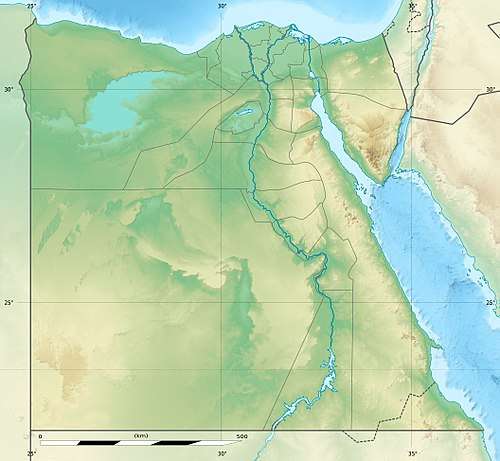Sadd el-Kafara
Sadd el-Kafara ("Dam of the Infidels") was a masonry embankment dam on Wadi al-Garawi 10 km southeast of Helwan in Helwan Governorate, Egypt. The dam was built in the first half of the third millennium BC by the ancient Egyptians for flood control and is the oldest dam of such size in the world.[1][2][3] Never completed, the dam was under construction for 10–12 years before being destroyed by a flood. It was rediscovered by Georg Schweinfurth in 1885.[4]
| Sadd-el-Kafara | |
|---|---|
 Location of Sadd-el-Kafara in Egypt | |
| Location | Helwan, Helwan Governorate, Egypt |
| Coordinates | 29°47′43″N 31°25′55″E |
| Construction began | ~2650 BC |
| Dam and spillways | |
| Type of dam | Embankment, masonry |
| Impounds | Wadi Garawi |
| Height | 14 m (46 ft) |
| Length | 110 m (360 ft) |
| Width (crest) | 56 m (184 ft) |
| Width (base) | 98 m (322 ft) |
| Reservoir | |
| Creates | Sadd-el-Kafara Reservoir |
| Total capacity | ~570,000 m3 (20,000,000 cu ft) Est. |
Specifications
The dam was not finished but was about 111m long and 14m tall with a base width of 98m and crest width of 56m.[5] The dam's core was 32m wide and consisted of 60,000 tons of earth and rock-fill. Surrounding the core were two loosely filled rubble and rock-fill layer-walls. The downstream wall was about 37m wide, the upstream wall about 29m wide and they encompassed 2,900 m3 (100,000 cu ft) of material. Encasing the dam were upstream and downstream walls created from limestone ashlars. The ashlars were set but not mortared in stepped rows.[6] Each ashlar was roughly 30 cm (12 in) high, 45 cm (18 in) wide, 80 cm (31 in) long and roughly 50 lb (23 kg).[1]
Destruction
Because of erosion on the downstream face of the incomplete dam and its lack of a spillway, it is believed that a flood destroyed it. In addition, there was no evidence of a trench or tunnel that would have diverted water in the wadi around the construction site. Construction on the upstream side of the dam was mostly complete but the downstream side was much less developed. The crest of the dam sloped towards the center which the engineers may have intended to use as a spillway. However, as the top of the dam was not beheaded it was not protected from flood water that would over-top the crest. The dam's proximity to the fertile Nile River and distance from populations indicates it was built for protection against such events, similar to those that still occur today.[4] If complete, the dam would have stored 465,000 m3 (16,400,000 cu ft) – 625,000 m3 (22,100,000 cu ft) of water and flooding would have caused the reservoir to flood into adjacent parallel wadis. The dam's failure likely made Egyptian engineers reluctant to construct another for nearly eight centuries.[2]
Another indication that the dam may have been diminished due to flooding, or an overflow, is that the dam, itself, did not contain high quantities of silt, implying that the dam did not last long enough for the river to leave an obvious residual fingerprint on it.[7]
See also
- Jawa Dam
References
- Fahlbusch, Henning. "Early Dams" (PDF). History Association. Retrieved 20 July 2010.
- "Key Developments in the History of Embankment Dams". SimScience. Archived from the original on August 31, 2011. Retrieved 20 September 2018.
- "The Nile and Its Masters: Past, Present, Future: Source of Hope and Anger". CRC Press. 1 January 2001. Archived from the original on 6 December 2019. Retrieved 6 December 2019.
- Bard, Kathryn A.; Steven Blake Shubert (1999). Encyclopedia of the archaeology of ancient Egypt. Routledge – Taylor & Francis Group. pp. 1057–1062. ISBN 0-203-98283-5.
- "Sadd-el-Kafara Dam". Structurae. Retrieved 21 July 2010.
- Jansen, Robert B. "DAMS FROM THE BEGINNING". USSDams.com. Retrieved 21 July 2010.
- Saxena, K.R. (2005). Dams: Incidents and Accidents. A.A. Balkema.